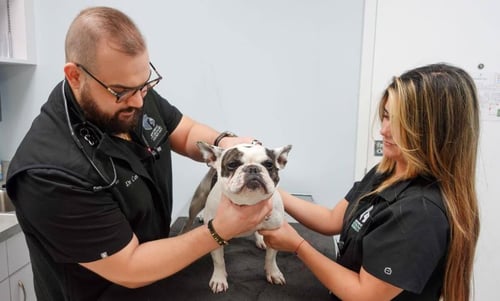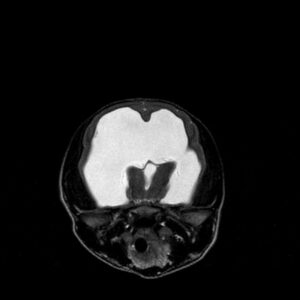Hydrocephalus in Dogs: The Importance of Early Diagnosis
What is hydrocephalus in dogs? Well, in Greek, “hydrocephalus” basically translates to “water on the brain.” Hydrocephalus is a neurological condition caused by too much fluid in the brain. As the brain swells with excess fluid, it becomes compressed within the confines of the skull. Brain compression causes neurological symptoms and can lead to death of the surrounding tissue.

Symptoms of Hydrocephalus in Dogs
Clinical signs of hydrocephalus in dogs can vary according to which part of the brain is being compressed, the extent of brain damage, the age of the dog when the condition arose, and the cause of fluid buildup. Some dogs can live mostly normal lives with the condition while others will suffer with debilitating neurological symptoms.
Signs of hydrocephalus in dogs may include:
- Compulsive circling or spinning
- Large dome-shaped skull and persistent fontanelle (soft spot on head)
- Wide set eyes and abnormal eye position (fixed down and out)
- Difficulty learning and housetraining
- Difficulty drinking and eating
- Personality and behavior changes
- Head pressing
- Inappropriate vocalization
- Blindness
- Seizures
Causes of Hydrocephalus In Dogs
Cerebrospinal fluid (CSF) surrounds the brain and spinal cord, protecting delicate tissue and providing nutrients. It is produced in the ventricles of the brain and reabsorbed by the body as it completes its necessary tasks. However, excess CSF can accumulate in the brain if:
- The flow or absorption of CSF is obstructed
- Too much CSF is produced
In dogs, obstruction is much more common, and there are two basic types: congenital and acquired. While the outcomes are the same, the causes are different.
Congenital Hydrocephalus
Dogs with congenital hydrocephalus were born with a defect in the structures that normally facilitate the flow or absorption of CSF. When dogs are born with hydrocephalus, the skull is still soft enough to expand as the brain swells with fluid, leading to a large dome-shaped head and often an obvious open fontanelle.
Certain dogs are predisposed to congenital hydrocephalus, especially toy and brachycephalic breeds such as:
- Chihuahua
- Yorkshire terrier
- Boston terrier
- Pomeranian
- English bulldog
- Lhasa Apso
- Pug
- Pekingese
- Maltese
- Toy poodle
Acquired Hydrocephalus
Acquired hydrocephalus can happen in any breed at any age. Dogs with acquired hydrocephalus are born with normal brains, but develop a blockage that interferes with the flow or absorption of CSF. The most common development is a brain tumor, but there are other possibilities.
Causes of acquired hydrocephalus include:
- Brain tumor
- Brain trauma
- Brain hemorrhage
- Bacterial or viral brain infection
- Inflammatory brain disease
- Vitamin A deficiency
- Exposure to certain drugs, chemicals, or toxins

Diagnosis of Hydrocephalus in Dogs
Because hydrocephalus can result in the death of brain tissue, early diagnosis is important.
Congenital hydrocephalus can often be recognized just by the distinctive head shape and symptoms. However, a vet will typically order tests to confirm it. Plus, many dog breeds predisposed to hydrocephalus are predisposed to other conditions, so it’s also important to rule these out.
Testing should include physical and neurological exams, blood and chemistry profiles, blood count, electrolyte panel, and urinalysis. Once other conditions are ruled out, MRI and CSF analysis can be used for a definitive diagnosis.

MRI is the most reliable and comprehensive method for diagnosing hydrocephalus in dogs. Not only can we see the enlarged ventricles, but we can also see what’s causing it. In some cases, a spinal tap is performed following an MRI to check for infection.
Treatment of Hydrocephalus in Dogs
Treatment of hydrocephalus depends on the severity, type, and cause. However, in most cases, hydrocephalus in dogs is managed and not cured. For mild to moderate hydrocephalus, treatment will usually begin with medications:
- Corticosteroids reduce inflammation and pressure
- Proton-pump inhibitors decrease CSF production
- Diuretics can increase the outflow of CSF and decrease CSF production
- Anti-seizure medications reduce frequency, duration, and severity of seizures
Unfortunately, medical treatment often only provides a temporary solution. More definitive treatment requires surgery with a highly specialized neurosurgeon.
For hydrocephalus that is severe or not responding to medications, ventriculoperitoneal (VP) shunting is recommended. A specialized tube is surgically placed under the skin to redirect fluid from the brain to the belly. Shunt placement is a complex procedure that carries considerable risk, but it is a long-term solution with a high success rate in the right hands, such as the experts at Southeast Veterinary Neurology. Patients continue to require close monitoring and may need subsequent surgeries to replace shunts that have been outgrown, moved, or otherwise failed.
Southeast Veterinary Neurology is Highly Experienced with Hydrocephalus in Dogs
Hydrocephalus is a serious and often life-threatening condition. For dogs with mild symptoms and dogs that respond well to treatment, outcomes can be positive. For severely symptomatic dogs, dogs that do not respond to treatment, and dogs with untreatable underlying causes, the outlook is less optimistic.
It’s critical to address hydrocephalus in dogs early to have the best chance of recovery. So, if you have noticed any of these signs in your puppy or dog, please visit a highly experienced veterinary neurologist, such as those at Southeast Veterinary Neurology in Miami, Boynton Beach, Jupiter, and Virginia Beach. Call a location near you today!

